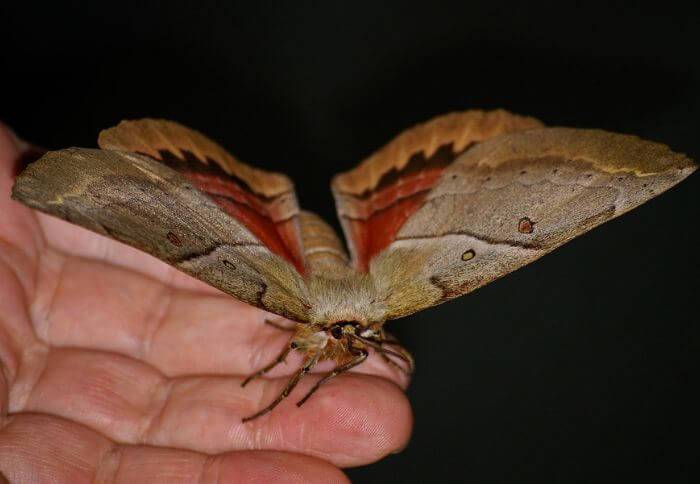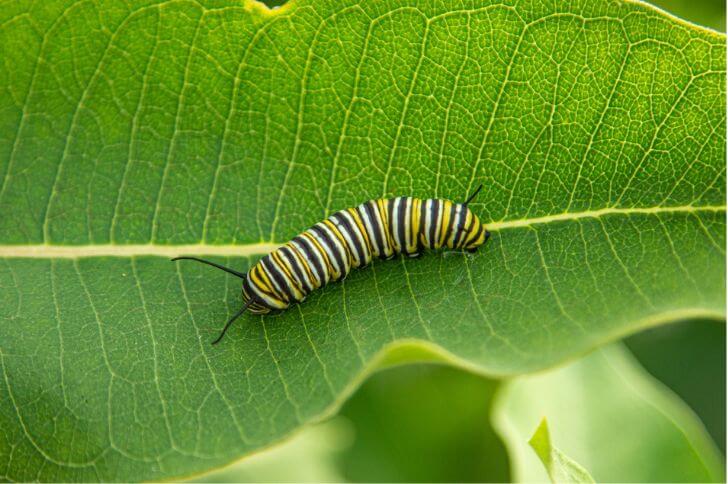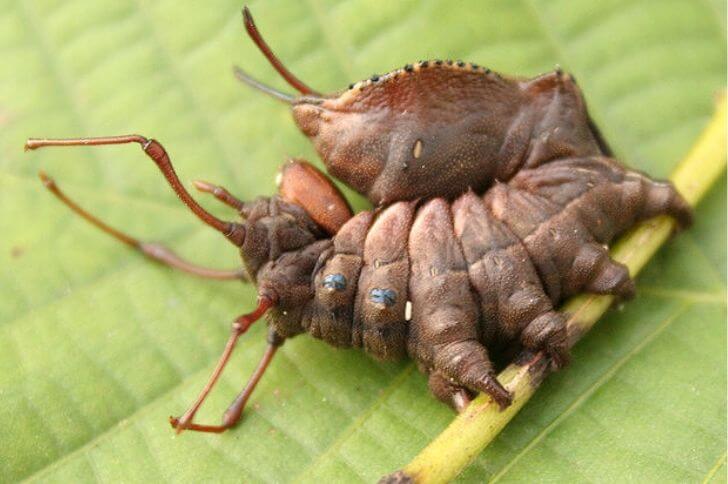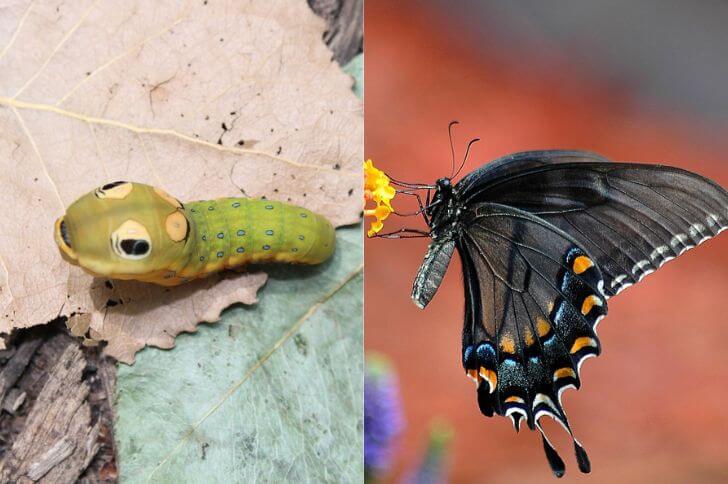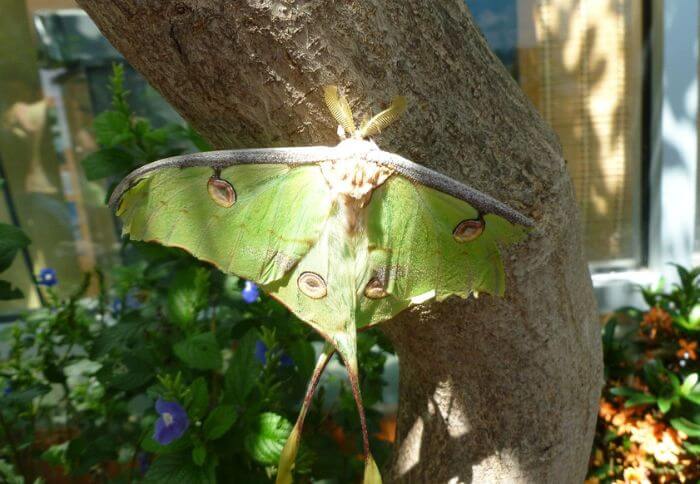7 Black and Red Caterpillars with Spikes (ID)
Crawling gracefully on the verdant leaves, black and red caterpillars with spikes are a captivating sight to behold in the world of insects.
With their striking coloration and unique physical features, these mysterious creatures have long fascinated entomologists and nature enthusiasts alike. From the tiny larvae that curl up into a defensive pose to the larger species that flaunt their fiery spines as a warning signal, there is an undeniable allure surrounding these types of caterpillars.
In this article, we will delve into the mesmerizing world of black and red caterpillars adorned with spikes, uncovering their various types and unravelling the secrets behind their evolutionary adaptations.
List of black and red caterpillars with spikes
1. Giant Leopard Moth caterpillar
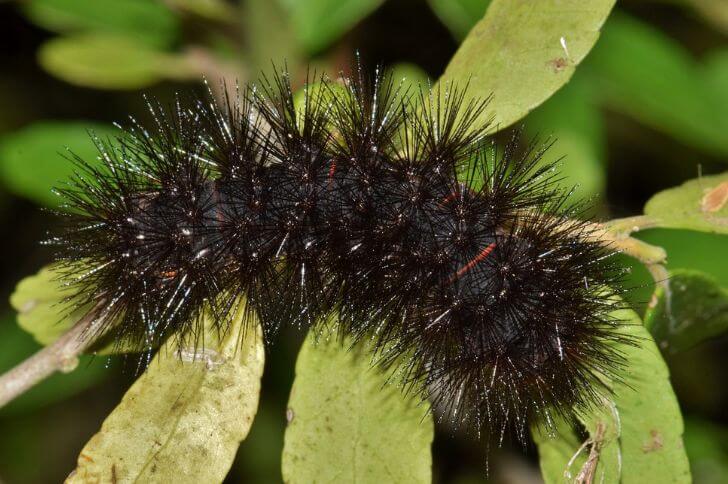
One of the most fascinating creatures you may encounter in your backyard is the Giant Leopard Moth caterpillar. This unique caterpillar stands out with its striking black and red coloration, creating a bold statement that demands attention.
Its body is adorned with black spikes, adding an extra layer of intimidation to its already eye-catching appearance.
Also, aside from its distinctive appearance, this black and red caterpillar with spikes has a few tricks up its sleeve to defend itself from predators. When threatened, it coils its body making the spikes appear longer.
Overall, encountering a Giant Leopard Moth caterpillar provides not only aesthetic enjoyment but also an opportunity for reflection on the wonders of nature and how different organisms have adapted over time for their own protection.
2. Spiny Elm Caterpillar
The spiny elm caterpillar is truly a creature that commands attention with its striking appearance. With its vibrant black coloration with bright red spots, this caterpillar stands out amongst the green foliage it calls home. However, it is not just its colors that make it unique – it is also adorned with rows of spiky projections along its body.
These spines serve a dual purpose for the caterpillar. First and foremost, they act as a defense mechanism against potential predators. These sharp spikes make it difficult for any predator to get a grip on the caterpillar, providing protection from birds or other insects looking for an easy meal.
Additionally, studies have shown that these spines can deliver mild venom when touched, acting as an additional deterrent against would-be attackers.
Despite the fearsome appearance of the spiny elm caterpillar, it does possess some endearing qualities. For instance, despite their spikes and bold colors, they are completely harmless to humans and pets alike.
In fact, if approached gently and given some time to acclimatize to human touch, these curious creatures may even inch along your fingers in search of new adventures!
3. Pipevine Swallowtail Caterpillar
Native to Florida and parts of the Eastern US, the pipevine swallowtail caterpillars may appear menacing with its black coloration and rows of red spikes, but it is far from being a villainous creature.
This caterpillar feeds on the leaves of the pipevine plant, which contains toxins that make this caterpillar unpalatable to predators.
The female butterfly lays her eggs exclusively on the pipevine plant, ensuring that her offspring will have enough food to thrive. Once hatched, the caterpillars start their voracious feeding frenzy immediately – consuming copious amounts of leaves as they grow rapidly in size.
This swallowtail caterpillar is known for its ability to sequester toxic compounds from its host plant during feeding. These toxins are stored in specialized glands within their bodies and serve as a defense mechanism against potential predators at later stages of their lifecycle.
This remarkable adaptation allows them to become distasteful or even deadly to animals attempting to eat them.
4. Question Mark Caterpillar
Another fascinating creature in the insect world is undoubtedly the question mark caterpillar. With its striking black body and unique red spikes along its body, it is hard to miss this enchanting creature as it inches along tree branches.
But what makes this particular caterpillar so special is not just its appearance, but also its intriguing life cycle.
Starting off as a tiny egg laid on leaf undersides, the question mark caterpillar hatches into a larva that undergoes several molts. As it grows, the distinct black and red colors become more pronounced, serving as a visual warning to predators that this little creature means business.
But perhaps even more captivating are the spikes that adorn its body. These spikes may look menacing, but they actually serve a more defensive purpose – deterring would-be attackers from taking a bite out of this potential delicacy.
What do question mark caterpillars eat? They have a diverse diet that includes a variety of leafy greens. One of their preferred food sources is the American elm, which they happily munch on. However, these voracious eaters are not limited to elms alone. They are also known to feed on other plants such as nettle and hackberry among others
As with all black and red caterpillars with spikes, the question mark caterpillar ultimately transforms into a chrysalis before emerging as an adult butterfly.
5. Western Tussock Moth Caterpillar
The Western tussock moth caterpillar may seem like a small creature, but it is definitely hard to miss. Sporting vivid black and red colors, this caterpillar stands out in the natural world. But what truly sets it apart are the numerous spikes covering its body.
These white spikes not only serve as a visual deterrent to potential predators but also provide protection from curious fingers and hands.
While it’s easy to be captivated by its striking appearance, there’s more than meets the eye with the Western tussock moth caterpillar. This little critter has developed a fascinating survival strategy that involves feasting on a variety of host plants.
By consuming different types of foliage, this caterpillar is able to acquire toxic compounds called pyrrolizidine alkaloids that make it unpalatable for many predators. It’s almost as if this tiny insect has perfected an artful blend of aesthetics and defense mechanisms.
Related Read: learn about common black fuzzy caterpillars
6. Indian Fritillary Caterpillar
Indian fritillary caterpillars are beautiful creatures that mesmerize with their unique black and red/orange coloration. With their black heads, body and legs, a bold orangish red stripe on its back and bright markings of their body, these caterpillars can easily catch the eye of any observer.
But it’s not just its striking appearance that sets it apart; the Indian fritillary caterpillar also boasts an array of long, sharp spines on its sides, serving both as a defense mechanism against predators and an intriguing feature to study.
What do these black and red caterpillars eat? Like other fritillary caterpillars, these caterpillars are extremely picky on what they eat. They mostly feed on leaves of violets.
Are Indian Fritillary caterpillars poisonous? No, unlike most spiky caterpillars, these are not poisonous. The bright coloring and spikes are only to fool their predators.
7. Azalea Caterpillar
Like most caterpillars, the azalea caterpillar goes through several molts in its larval stage. When it hatches, this small caterpillar has a black body with bold white marking and red head and legs.
A few days later the white fades into a yellow. Its body is covered by white hairs. This little critter may seem harmless at first glance, but don’t let its charming appearance fool you. The Azalea Caterpillar is actually quite destructive, known for feasting on the leaves of various plants and shrubs, particularly azaleas.
Also, those long spikes on its body aren’t just for show – they are an effective defense mechanism. When threatened, the Azalea Caterpillar raises these spiky appendages in a menacing display that acts as a deterrent to would-be attackers.
Despite its somewhat destructive nature, there is an undeniable beauty in observing the life cycle of the azalea Caterpillar. From its initial stage as a tiny egg laid on plant leaves, it transforms into a hungry larva that voraciously devours foliage before cocooning itself into a pupa.
And finally, after weeks of transformation within this protective casing, emerges an adult moth ready to continue the cycle all over again. So next time you come across an azalea bush or plant being devoured by these unique creatures, take a moment to appreciate their intriguing life story and perhaps find inspiration in their resilience and adaptability in the face of adversity.
8. Erasmia Pulchella Caterpillar
The Erasmia Pulchella caterpillar: a creature that could easily be mistaken for something from another planet. With its distinctive black and red coloring, adorned with small spikes covering its body, this caterpillar is truly a magnificent sight to behold.
Did you know that the Erasmia Pulchella caterpillar feeds exclusively on Helicia cochinchinensis? These plants contain toxic chemicals which help them build up cyanide compounds in their tiny bodies.
These toxins make this moth poisonous throughout its life stages.
Final Thoughts:
There are several types of black and red caterpillars with spikes that can be found in various parts of the world. These include the giant leopard moth caterpillar, the spiny elm caterpillar among others.
Each species has its own unique characteristics and behaviors, but they all share a common defense mechanism – their spikes. These spikes serve as a warning to potential predators, indicating that these caterpillars are not to be messed with.
If you happen to come across one of these fascinating creatures in your garden or on a nature hike, be sure to admire them from a safe distance and appreciate the incredible diversity of our natural world.
sources:
https://content.ces.ncsu.edu/azalea-caterpillar
https://entnemdept.ufl.edu/creatures/MISC/MOTHS/Hypercompe_scribonia.htm

Passionate animal enthusiast and skilled writer with a flair for captivating storytelling. With over five years of experience, I have crafted engaging content that sheds light on the fascinating world of animals.
Through my articles, blog posts, and social media campaigns, I strive to raise awareness about conservation efforts and promote a deeper understanding of the natural world.
